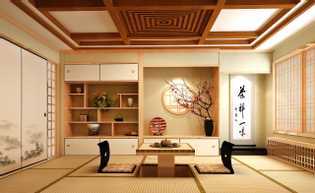畳(たたみ) - Tatami (straw and rush mats)
Traditional Japanese-style rooms have floors of tatami mats. The mats are made of straw and rush and consist of a thick base and a soft, smooth surface that covers the base. The thick base is made of dried straw that is packed and sewn, and the smooth surface of woven rush. The tatami mats are approximately 180 by 90 centimeters (6 feet by 3 feet) with a thickness of 6 centimeters (2.4 inches), but the size of the tatami mats varies in the different regions across Japan. As tatami mats have a standardized size, they can be used to measure room sizes. Then, one mat is referred to as 1 jo (ichi-jo) and the size of a six-mat room, for example, is expressed as 6 jo (roku-jo). In addition to six-mat rooms, four and a half-mat rooms and eight-mat rooms are the most common in Japanese houses.
畳は伝統的な日本間の床に敷かれているマットのことで、藁(わら)といぐさでできています。乾燥した藁を重ねて押し固めながら縫った厚い台の部分に、いぐさで編んだ滑らかで柔らかい畳表をかぶせて作ります。畳一枚の大きさは、地方によって若干異なりますが、およそ縦180cm、横90cm (縦6フィート、横3フィート)で、厚さは約6cm (2.4インチ)です。畳は、その大きさが一定であることから、畳一枚が1畳と呼ばれ、部屋の広さを表す単位としても用いられます。4畳半、6畳、8畳が最も一般的な部屋の広さです。
It is said that tatami mats have been used in Japan since the Heian period (A.D. 794 – A.D. 1191), but tatami mats were only placed where people sat. The rest of the floor was made of boards then. It was in the Muromachi period (A.D. 1333 – A.D. 1568) that people began to use tatami to cover the entire floor area. Even today, most Japanese houses have at least one traditional Japanese-style room, which is furnished with tatami mats, fusuma (paper-covered sliding doors), and shoji (sliding paper doors and windows).
日本人が畳を使い始めたのは、平安時代であると言われています。当時は、板張りの床の上に人が座る分だけの畳を敷いていました。室町時代になって、部屋中に畳を敷き詰めるようになりました。今日でも、ほとんどの日本の住居には少なくとも1部屋は伝統的な和室があり、床に畳が敷かれ、建具には襖(ふすま)または障子(しょうじ)が取り付けられています。
Tatami mats Feel smooth and never get damp. They are the ideal material for floors in Japanese houses as the humidity is high all year round due to the climate. We can always keep tatami mats in good condition by simply having their surfaces periodically replaced by expert tatami makers. We can enjoy the refreshing scent of woven rush when the surfaces are replaced.
畳は肌触りがよく、湿っぽくならないため、湿度の高い日本の住居には理想的な床材であると言われています。畳は、専門の職人による「表替え」(畳表だけを張り替えること)を定期的に行うことによって、常に良い状態に保つことができます。表替えをすると、畳の良い香りがし、すがすがしい気分になります。
The longer sides of the tatami are bordered with cloth. In the old days, the colors and patterns of the cloth depended on the status of the family, but people can chose their favorite colors and patterns freely today. When we walk in a tatami-matted room, it is bad manners to step on the borders. This is because the borders damage and wear easily if they are stepped on.
畳の長い方の辺には、布の縁(へり)が付けられています。昔は、家庭の身分によってその色や柄が決まっていましたが、現在では好みの色や柄が自由に使われています。畳を敷いた和室を歩くときのマナーとして、畳の縁を踏んではいけないことになっています。これは、畳の縁を踏むと縁が擦り切れて傷むからです。
